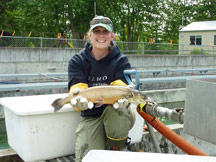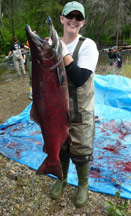Jenna Davis, College Intern II
Sport Fish Division - Anchorage

I spent the summer of 2012 in Anchorage, Alaska working at the William Jack Hernandez Sport Fish Hatchery (WJHSFH) and the Fort Richardson (Fort Rich) Fish Hatchery through the Alaska Department of Fish and Game. The WJHSF hatchery is one of the most state-of-the-art hatchery facilities in the U.S. Production, coupled with bio-security, are the two main components of this facility. This facility rears 5 different species, rainbow trout, Chinook (king) salmon, coho salmon, Arctic char, and Arctic grayling. For these species, the hatchery is split to prevent the spread of diseases species to species. The production floor is split into three sections for rainbow trout, king salmon, coho salmon and Arctic char. There are separate rooms for juvenile char, and rainbow as well as a brood room for rearing rainbow trout, grayling, and char after incubation (which is in an adjoining room). I mainly worked in the brood rearing room.
Each morning I would start at the WJHSF hatchery. Work included cleaning the rainbow trout brood room as well as the rearing rooms for grayling, Arctic char, and rainbow trout (over 20 tanks total), making sure there were no mortalities, and filling the automatic feeders. And at the end of each month, we would take weight samples to calculate feed rates for each tank.
After this, I would drive to Fort Rich and take care of the brood stock there. Due to biosecurity, I would spend the rest of the day at Fort Rich. The daily routine consisted cleaning and feeding the Stormy Lake char tank inside; then going outside to give a round of feed to the raceways, which were hand fed. After one round was fed I would sweep the raceways. This would be done while alternating feeding the rest of the ration for the raceways. At the end of the day, I would go into a contaminated area where we were raising rainbow trout that had acute bacteria kidney disease and I would sweep those raceways and feed them.
We also separated ripe males and females to place into other raceways. This was a very cold experience but definitely a lot of fun! I was able to help culture artemia for grayling as well. This was done because grayling, when they are small, are too small to eat fish meal. I helped with an egg take on Deception Creek, which a unique experience because it was on location. And, on my very last day, I was able to participate in a stocking run.

I am very fortunate to have had this experience in the heart of Alaska. I was able to make great friends and see some gorgeous country. I was able to see the hatchery system in whole from when eggs were brought in and hatched to rearing those fry to the production floor and then stocked out in lakes. This was a wonderful opportunity that helped me narrow down what I want to go into within the fisheries world.
